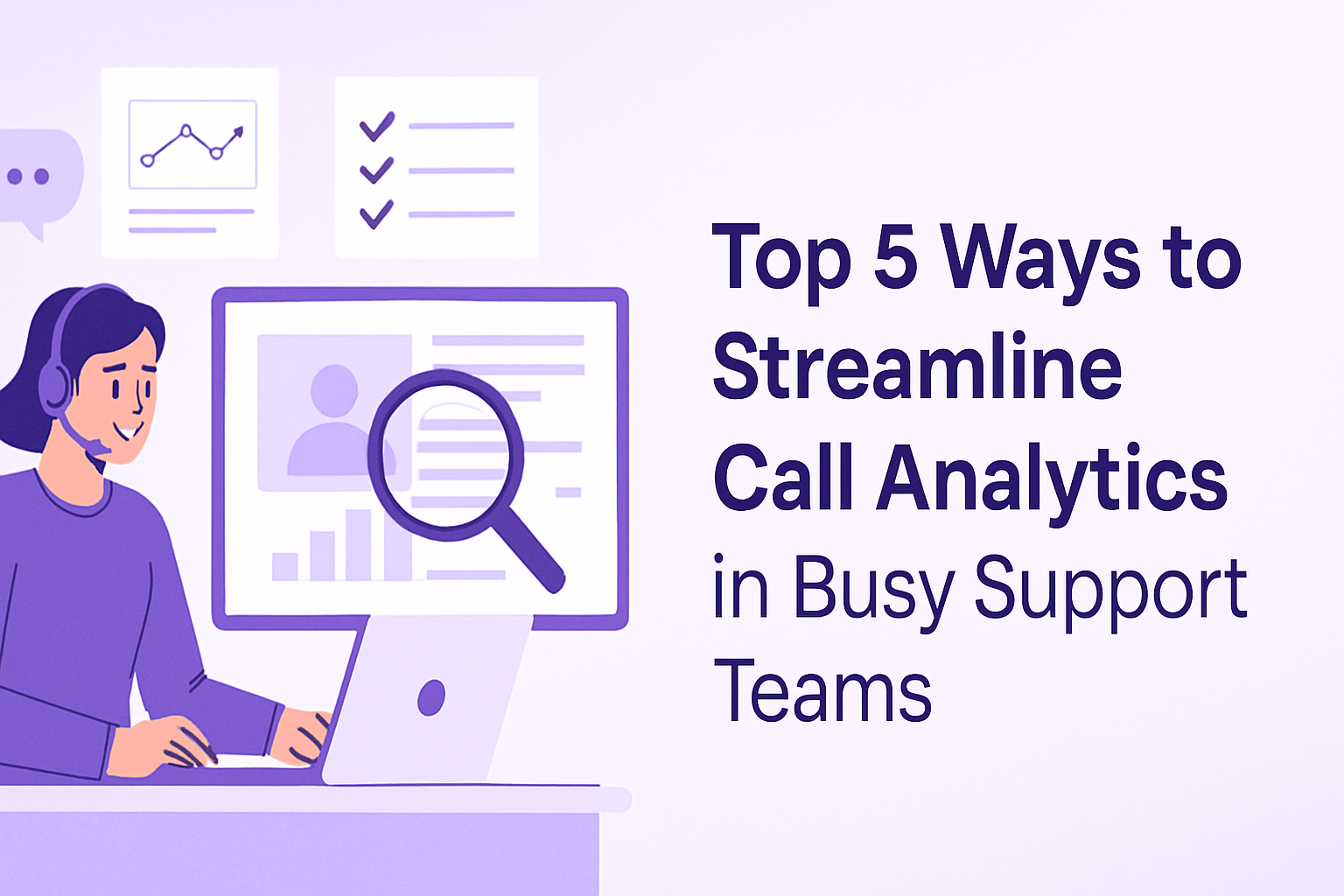How To use AI Call Analytics to Automatically Summarize Customer Conversations
-
Hello Insight
- 10 min read
How To use AI Call Analytics to Automatically Summarize Customer Conversations
AI call analytics is revolutionizing how businesses understand and enhance customer interactions. By leveraging advanced technologies, organizations can automatically summarize customer conversations, providing invaluable insights that drive product development and market strategies. This guide explores the benefits of AI call analytics, how it works, and best practices for implementation to ensure maximum value from customer interactions.
The Role of AI Call Analytics in Modern Business Operations
In today's competitive landscape, understanding customer feedback has become crucial for success. Traditional methods of analyzing customer conversations are often inefficient, leading to missed opportunities for product improvement and customer satisfaction. AI call analytics automates the analysis process, transitioning businesses from a reactive stance to a proactive one, enabling them to anticipate customer needs and preferences.
This technology streamlines the collection and analysis of data from various communication channels, creating alignment across teams and improving overall business performance. With AI-driven insights, companies can swiftly translate customer feedback into actionable strategies, ultimately enhancing their product and go-to-market (GTM) lifecycle.
What is AI Call Analytics?
AI call analytics refers to the use of artificial intelligence technologies to analyze customer calls and extract insights that inform business decisions. Unlike traditional methods that focus on manual transcriptions and human interpretation, AI call analytics leverages machine learning and natural language processing to provide real-time summaries and insights from customer conversations.
Core Capabilities:
- Automated Summarization: Generates concise summaries of customer interactions, saving time and improving understanding.
- Sentiment Analysis: Assesses customer emotions and sentiments expressed during calls, aiding in customer experience enhancements.
- Performance Metrics: Evaluates agent performance based on predefined criteria, facilitating training and development opportunities.
- Contextual Insights: Provides contextualized insights that can inform product development and marketing strategies.
- Trend Identification: Detects emerging trends and common customer issues, guiding strategic business decisions.
Strategic Value: By enabling proactive decision-making and better alignment across departments, AI call analytics empowers organizations to act decisively based on customer feedback and insights.
Why Are Consultants and Insight-Seeking Personnel Investing in AI Call Analytics?
Context Setting: As organizations increasingly recognize the value of customer feedback, many are transitioning from outdated methods to AI-driven solutions that offer real-time insights. This shift is driven by the need for agility and responsiveness in an ever-changing market.
Key Drivers:
- Efficiency: Traditional call analysis methods are time-consuming and often yield subpar results. AI automates these processes, freeing up valuable resources.
- Enhanced Accuracy: AI call analytics can process large volumes of data with a high degree of accuracy, providing more reliable insights than manual methods.
- Actionable Insights: The ability to quickly identify actionable insights empowers businesses to refine their products and services effectively.
- Scalability: As organizations grow, AI-driven analytics can scale efficiently, adapting to increased call volumes without sacrificing quality.
What Data Powers AI Call Analytics?
Foundation Statement: To build effective AI call analytics systems, organizations need access to diverse data sources that can be integrated seamlessly.
Data Sources:
- Call Transcripts: Automated transcriptions of customer calls provide the foundation for analysis.
- CRM Data: Integrating customer relationship management data enhances understanding of customer profiles and behaviors.
- Feedback Channels: Data from platforms like Salesforce, Gong, and HubSpot enriches the analysis with additional context.
- Multimodal Inputs: Video and audio inputs can be processed to provide a comprehensive view of customer interactions.
- Historical Data: Previous call data is essential for training AI models and improving accuracy over time.
Accuracy Benefit: A multi-source approach ensures that AI call analytics yield more comprehensive and accurate insights, enabling better decision-making.
Key Components of an AI Call Analytics Stack
Stack Overview: An effective AI call analytics stack comprises several critical components that work together to analyze and summarize customer conversations.
Component Descriptions:
- Data Ingestion Layer: Collects data from various sources and formats, ensuring a comprehensive dataset for analysis.
- Processing Engine: Analyzes audio, text, and video data to extract key insights and generate summaries.
- Machine Learning Algorithms: Utilize historical data to improve the accuracy of sentiment analysis and performance metrics.
- Reporting Interface: Provides intuitive dashboards that visualize insights, trends, and performance metrics for easy interpretation.
- Integration Capabilities: Allows seamless integration with existing CRM and communication systems to streamline workflows.
Quality Emphasis: Ensuring high-quality data and interpretability is essential for meaningful results from AI call analytics.
How Does AI Call Analytics Work Step by Step?
Step 1: Data Collection
Data is collected from various channels, including call recordings, CRM systems, and customer feedback platforms, ensuring a rich dataset for analysis.
Step 2: Data Processing
The collected data is processed using AI algorithms that transcribe calls and analyze the content for sentiment and key themes.
Step 3: Analysis
The system identifies patterns in customer interactions, such as common complaints or positive feedback, allowing for targeted insights.
- Pattern Type 1: Common customer pain points.
- Pattern Type 2: Agent performance metrics.
- Pattern Type 3: Sentiment trends over time.
Step 4: Learning
Machine learning models are trained using historical data to improve the accuracy of insights and predictions, refining the analysis process.
Step 5: Real-time Processing
AI call analytics can process data in real-time, providing immediate insights that enable rapid response to customer needs.
Step 6: Output Delivery
Insights are delivered through user-friendly dashboards and reports, highlighting actionable recommendations for teams to implement.
- Example Output 1: Summary report of customer satisfaction trends.
- Example Output 2: Performance scores for agents based on specific criteria.
- Example Output 3: Visualizations of emerging customer issues.
Where Can Consultants and Insight-Seeking Personnel Apply AI Call Analytics?
Use Case 1: Customer Experience Improvement
- Prediction Method: Analyze customer feedback to identify areas for improvement.
- Recommended Action: Implement changes based on summarized insights to enhance customer satisfaction.
Use Case 2: Training and Development
- Analysis Approach: Evaluate recorded calls to identify training opportunities for agents.
- Follow-up Action: Schedule training sessions based on insights gathered from call performance metrics.
Use Case 3: Product Development
- Identification Method: Use sentiment analysis to gauge customer reactions to new features.
- Proactive Scheduling: Engage product teams to address concerns highlighted in customer conversations.
Use Case 4: Marketing Strategy Refinement
- Forecasting Approach: Analyze trends in customer inquiries to inform marketing campaigns.
- Optimization Action: Adjust messaging based on insights gained from customer sentiment.
What Tools Can You Use for AI Call Analytics?
When selecting tools for AI call analytics, look for platforms that offer comprehensive features, such as data integration, real-time processing, and user-friendly reporting capabilities.
Comparison Table:
| Feature | Insight7 | Traditional Alternative |
|---|---|---|
| Automated Summarization | Yes | No |
| Sentiment Analysis | Yes | Limited |
| Performance Metrics Evaluation | Yes | Manual |
| Integration Capabilities | Extensive | Limited |
| Real-time Insights | Yes | No |
Common Pitfalls in AI Call Analytics Implementation
Context Warning: Many organizations struggle with implementing AI call analytics due to a lack of strategy and understanding of the technology.
Major Pitfalls:
- Inadequate Data Quality: Poor data quality can lead to inaccurate insights and ineffective decision-making.
- Stakeholder Misalignment: Without alignment among teams, the implementation may fail to meet business needs.
- Technical Limitations: Insufficient technical infrastructure can hinder the effectiveness of AI solutions.
- Integration Challenges: Difficulty integrating with existing systems can limit the functionality of AI call analytics.
Success Foundation: Successful implementation starts with a clear strategy and commitment to data quality and stakeholder engagement.
How Do You Get Started with Insight7?
Step 1: Integration Capability
Assess the integration capabilities of Insight7 with existing platforms and communication systems.
Step 2: Data Synchronization
Synchronize data from various sources, ensuring a comprehensive dataset for analysis.
Step 3: Configuration Options
Configure the system settings to match your business needs and analysis criteria.
Step 4: Training Process
Utilize historical call data to train the AI models for improved accuracy.
Step 5: Customization Options
Customize the reporting and dashboard features for different teams and stakeholders.
Step 6: Ongoing Optimization
Regularly review and optimize the system based on user feedback and evolving business needs.
What Is The Best AI Call Analytics Setup?
ROI Optimization: To maximize the return on investment, organizations should focus on best practices in AI call analytics.
Best Practices:
- Use diverse data sources to enhance model accuracy.
- Involve stakeholders from various teams to ensure alignment.
- Regularly review historical data to inform ongoing analysis.
- Integrate automation to streamline processes.
- Establish a cadence for reviewing insights and refining strategies.
Building an AI Call Analytics Strategy That Scales
A scalable AI call analytics strategy requires cross-functional alignment and collaboration. Different teams must agree on the key metrics, data sources, and analysis methods that will drive success. Implementing prioritization and automated feedback mechanisms will ensure that the strategy evolves with the organization’s needs.
AI Call Analytics Benchmarks and Success Metrics
Evaluation Framework: Clear benchmarks are essential for measuring the impact of AI call analytics on business outcomes.
Core Metrics:
- Customer Satisfaction Score: Measures improvements in customer experience.
- Agent Performance Scores: Evaluates the effectiveness of training initiatives.
- Call Resolution Rates: Indicates how effectively issues are resolved.
- Sentiment Analysis Trends: Tracks changes in customer sentiment over time.
- Operational Efficiency Metrics: Reflects improvements in call handling and processing.
Universal Principle: The ultimate goal of AI call analytics is to facilitate better decisions and actions based on customer insights.
Frequently Asked Questions
Q: What is AI call analytics?
A: AI call analytics utilizes artificial intelligence to automatically analyze and summarize customer conversations, providing actionable insights.
Q: How does AI call analytics differ from traditional methods?
A: Unlike traditional methods that rely on manual analysis, AI call analytics automates the process, offering real-time insights and summaries.
Q: What platforms can be integrated with AI call analytics?
A: AI call analytics can integrate with popular platforms like Salesforce, Gong, and HubSpot for comprehensive data analysis.
Q: What data is required for effective AI call analytics?
A: Ideal data sources include call transcripts, CRM data, and customer feedback from various channels.
Q: How quickly can organizations expect to see results?
A: Implementation timelines vary, but organizations can often start seeing insights within weeks of integration.
Q: What security measures are in place for AI call analytics?
A: AI call analytics platforms typically comply with industry standards such as GDPR and HIPAA, ensuring data security and compliance.
Conclusion
AI call analytics is becoming essential for organizations looking to enhance customer interactions and drive strategic decisions. By leveraging the right platform, such as Insight7, businesses can glean meaningful insights from customer conversations, accelerating their product and go-to-market lifecycles. Utilizing AI-driven analytics empowers teams to make informed decisions that lead to improved customer satisfaction and operational efficiency.






